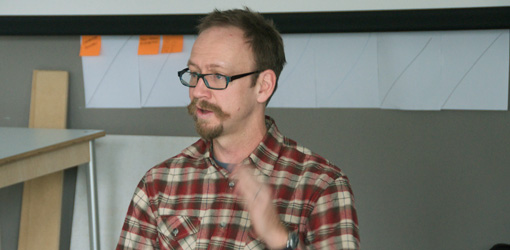Lunch in Progress 3
Posted on December 11, 2010 | posted by:With our minds and fingers limbered up from a game of Jenga, we welcomed our latest lunch in progress guest Nigel Snoad. Billed as a mysterious and elusive design thinker (with a PhD in Complex Adaptive Systems), we weren’t sure what to expect.
Lunch in Progress is our class’ round table format, a way to have an informal and in-depth conversation with prominent designers and thinkers (who are also usually trying to eat an unwieldy Vietnamese sandwich). As a class, we pepper our guests with our Transdisciplinary questions and receive amazingly thoughtful answers.
Nigel’s affable Australian personality shined as he launched into an explanation of his new project at the United Nations. The class was enthralled as he outlined the challenges of the project, coordinating relief organizations as well as the US military during disaster relief. His close, first hand knowledge of the crisis in Haiti and that country’s continuing instability were deeply insightful.
Nigel balances idealism with a heavy measure of realism. His previous experience working with UN and UNICEF as a designer, systems thinker, and information architect provides a solid framework to make positive change. Navigating a complex system such as the UN presents interesting challenges for a systems thinker.
One of the challenges Nigel identified was differentiating between complexity and chaos. How can something such as a disaster, a frenzied anarchic situation, be given an organized response, how can the right people be connected, how can values and common goals be established? A question from the class was: what can designers offer these situations or what place do designers have in an organization such as the UN?
His answer was characteristically considered: designers are currently being hired by organizations like the UN in roles formerly reserved for consultants: designers here have an edge with understanding information and organization, as well as human factors. Additionally, designers are being utilized as meeting facilitators, which also requires highly skilled information organization and communication.
Nigel’s perspective on design was a helpful one: he was working within his skill set to make a difference, using design both as tool as well as guidance, for thinking beyond the here and now. What is possible to with design? How can the coordination of information change the world?
His Linkedin profile summary reads: Thinking about how aid, information, risk and crisis management all come together, and how crowds, networks, design, tools, systems, experience and being thoughtful about complexity can help. The right tech makes a difference but it’s about people and proceses [sic] – how do the right people work together at the right time.
For further reading: Carrot, Sticks, and Sermons: Policy Instruments and Their Evaluation, by Marie-louis Bemelmans-vide (ed), Ray C. Rist (ed), and Evert Vedung (ed).
